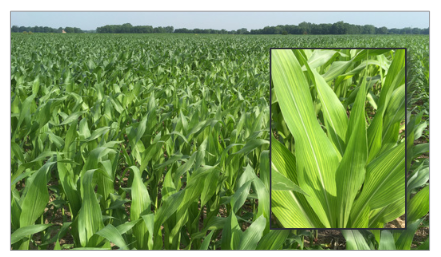The cost of seed corn represents 17% of farmers’ variable cost of production, second only to the cost of nitrogen (N) fertilizer.
Jim Camberato


This summary is based on 55 field scale research trials conducted at Purdue Ag. Centers and with on-farm collaborators around the state of Indiana from 2014 – 2022.

Sulfur Deficiency
Sulfur (S) deficiency has become more common in
Indiana crops because S emissions from coal-fired power
plants have decreased over the past few decades
(Camberato et al., 2022). Consequently, atmospheric S
deposition to soils has also decreased.
Sulfur deficient corn plants exhibit a general yellow-
green color from top to bottom of the plant, often also
with visible leaf striping (Fig. 1). Other nutrient deficiencies
can cause striping and can sometimes be confused with S
Sample to the proper depth and retain the whole soil core to get a representative soil sample.

In recent years, sulfur (S) deficiency has been diagnosed in corn, soybean, alfalfa, and wheat in the Midwest, including Indiana and Michigan.
MULTI–YEAR SUMMARY OF CORN RESPONSE TO NITROGEN FERTILIZER This report summarizes corn yield response to fertilizer nitrogen (N) rate in field–scale trials conducted around the state of Indiana since 2006. These results are applicable to N management programs that use efficient methods and timings of N fertilizer application. The Agronomic Optimum N Rate (AONR) represents the total amount of fertilizer N (including starter N) required to maximize yield, but not necessarily profit. The AONR in these trials varied among regions of the state from about 211 to 254 lbs N / ac, depending partly on soil organic matter and soil drainage characteristics. At five Purdue Ag. Centers where we conducted paired trials of corn following soybean (corn/soy) and corn following corn (corn/corn) from 2007 to 2010, the average AONR for corn/corn was 44 lbs greater than for corn/soy while average corn/corn yields were 18 bu / ac less than the[Read More…]

Corn yield response to increasing nitrogen (N) rate follows the Law of Diminishing Returns – as higher and higher increments of N are applied, the increase in grain yield becomes smaller and smaller (Figure 1). Eventually, maximum yield occurs and applying more N does not increase yield any further.
Corn yield response to increasing nitrogen (N) rate follows the Law of Diminishing Returns – as higher and higher increments of N are applied, the increase in grain yield becomes smaller and smaller (Figure 1). Eventually, maximum yield occurs and applying more N does not increase yield any further.

Starter 2×2 fertilizer in corn does not consistently increase grain yield but frequently reduces grain moisture at harvest by as much as 1.5 percentage points.
Phosphorus (P) and potassium (K) recommendations are made based on results of recent and representative soil samples.
© 2025 Purdue University | An equal access/equal opportunity university | Copyright Complaints | Maintained by Pest&Crop newsletter
If you have trouble accessing this page because of a disability, please contact Pest&Crop newsletter at luck@purdue.edu.


